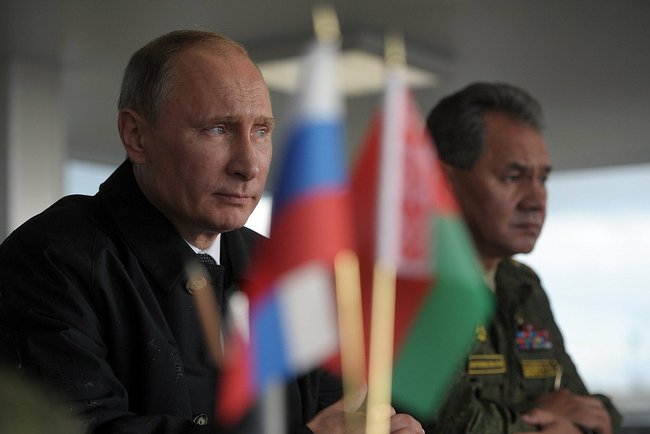
What Do the Zapad 2013 Exercises Reveal? (Part Two)
Publication: Eurasia Daily Monitor Volume: 10 Issue: 180
By:

On September 20–26, Russia carried out Zapad (“West”) 2013 military exercises with Belarusian forces. Though the training scenario envisioned repulsing an attack on Belarus by “terrorist” forces, Zapad 2013’s territorial scope, breadth of practiced operations, and the number of units and force types involved suggested Russia was practicing for a large-scale war against a conventional army (see Part One, EDM, October 4).
This large war scenario in many ways reflected the continuing hold of the dysfunctional and discredited Soviet military model on the Russian military-political mind. As Karl Marx famously observed, “The dead hand of all the generations of the past weighs like a nightmare upon the brain of the living”—so it is with the Russian military-political leadership. Moscow argued that the Zapad 2013 exercises represented a riposte to terrorists. But again, a little-publicized fact is that these simulated “terrorists” were apparently Balts intent on mounting operations in Belarus against that government and on behalf of their supposedly oppressed ethnic kinsmen. Moreover, the scope of the operation suggests that Moscow still cannot conceive of carrying out anti-terrorism or counter-insurgency operations in terms other than those of larger-scale conventional theater scenarios. In and of itself, that point is reminiscent of Soviet counter-insurgency operations, for example in Afghanistan.
Beyond those points it is also clear that Russia regards the North Atlantic Treaty Organization (NATO) as an enemy, despite concurrent cooperation with it. Indeed, just before these exercises, Defense Minister Sergei Shoigu told the Valdai Club forum that NATO is an enemy because of its pursuit of a comprehensive ballistic missile defense system and the Alliance’s continuing expansion (RIA Novosti, Foreign Broadcast Information Service–Central Eurasia [FBIS SOV], September 19). Missile defense, by Russian admission, will not represent a threat to Russia before 2020. Moreover, NATO has not accepted new members in years and no further enlargement is planned for the time being. These facts, coupled with NATO’s diminishing military strength in the face of budget austerity, call into question the seriousness of Russia’s stated threat assessments.
Shoigu recently argued that Russia’s defense ministry believes private and state-run businesses—such as transport and oil processing companies—should be mandated to hold reserves that could be used to supply army troops under extreme circumstance. Indeed, the Zapad 2013 exercises seem to have been conducted with those requests in mind because they revealed the total non-conformity of Russia’s mobilization plans to the country’s current capitalist economy. Evidently, Shoigu wishes to bring back the Soviet mobilization model despite the fact that it has long since been utterly discredited and is visibly and wholly dysfunctional. In fact, the defense minister explicitly compared the present situation to the Soviet period, clearly lamenting the uncertainty of transportation systems, the supplies of hydrocarbons and even hydroelectric power compared to that era (Moskovskiy Komsomolets Online, September 27; Interfax, September 30; FBIS SOV, September 27, 30).
Adding to this sense of illusion, Deputy Defense Minister Dmitry Rogozin, like his Tsarist and Soviet predecessors, critiqued the Russian finance ministry’s assessment of the failure of the defense modernization program by claiming that the defense industrial sector is growing annually at 12–14 percent and salaries are growing at 23–25 percent (Interfax, FBIS SOV, October 1). Nevertheless, even if the figures by Rogozin are correct, they imply that the Russian defense industry sector, like its Soviet predecessor, is value subtracting.
One cannot simply shrug off the Russian military’s potential, however, or the intentions of the country’s leaders. Russian legislation permits the president to deploy troops beyond Russia’s borders to defend the honor and rights of Russian citizens—the same justification used against Georgia in 2008. Moreover, he can do so without any recourse to the Duma. Or, in other words, the president is free, without any accountability whatsoever, to commit Russia to a war with its neighbors for reasons not unlike those rehearsed this year or in the Zapad 2009 exercise. Considering Russia’s current threats against the independence, integrity and sovereignty of Lithuania, Belarus, Ukraine, Georgia, Moldova and Armenia, as well as Vladimir Putin’s admission that the war in Georgia in 2008, including the use of separatists, was preplanned (kremlin.ru, August 10, 2012), clearly European security cannot be taken for granted even if no war is currently in sight (Ryan Maness and Brandon Valentino, “Russia and the Near Abroad: Applying a Risk Barometer for War,” Journal of Slavic Military Studies, XXV, No. 2, 2012, pp. 125–148).
Though menaced by militant insurgencies in the North Caucasus and in the face of a declining NATO, Russia still insists on refighting theater conventional, if not nuclear, war scenarios in Europe. The country’s military leaders openly claim that Russia is surrounded by enemies who aim to destroy the foundations of the state. They claim a strategic partnership with China while simultaneously rehearsing and conducting exercises against it (RT, July 14; see China Brief, September 12). However, the current leadership, like its forebears, has forgotten the lesson of excessive militarization of the economy and still invokes the Soviet model, which is now essentially a system of organized corruption that is dysfunctional to modern war. And like their predecessors, Russian leaders still hanker after the power to mobilize the entire economy during wartime. Nevertheless, this seeming delusion is little comfort to Russia’s neighbors and NATO’s members.




